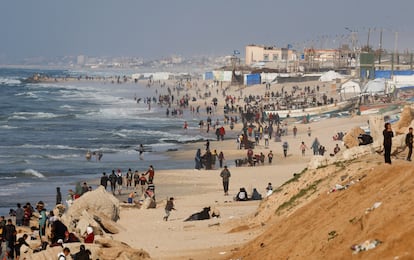EU explores safe maritime corridor from Cyprus to Gaza to transport urgent aid
Cyprus and Israel in December announced a humanitarian sea route to the Strip but it failed to materialize despite a successful trial run that shipped 90 tons of aid to Egypt last Christmas

The port of the Cypriot city of Larnaca has had a new tenant for the past three weeks: a red vessel of vast proportions stowed with 200 tons of food. It is the Open Arms, the flagship of the Spanish NGO of the same name, and its precious cargo is the aid that it and another organization — World Central Kitchen, run by the renowned Spanish chef José Andrés — have set out to transport to northern Gaza. Some 300,000 Palestinians remain in the north of the Strip after Israel’s bombing campaign against the enclave retaliation against the Hamas attacks of October 7 forced most of the population to move south. Cyprus is the closest European Union country to Gaza: the Open Arms is only 210 nautical miles (about 380 kilometers) from its destination. But for the moment the crew can only wait, because the Israeli authorities have not given it permission to dock and unload its supplies.
The EU wants to open a sea access route to Gaza to provide aid to the Strip after five months of war and a blockade by Israel that have left the population on the verge of starvation: half a million people are at risk and almost 16% of children suffer from acute malnutrition, according to the United Nations. To try to break the deadlock, the President of the European Commission, Ursula von der Leyen, will travel to Cyprus Friday with the intention of visiting the infrastructures related to some phases of a wider plan to enable a maritime humanitarian corridor.
The idea is not new. Shortly after the start of the Israeli attacks on the Palestinian enclave, which have already killed more than 30,000 people, the Cypriot government put forward a strategy known as the Amalthea Initiative, which was presented on December 20 in the port of Larnaca by the island nation’s Foreign Minister Constantinos Kombos and his Israeli counterpart at the time, Eli Cohen.
In his speech, Kombos described a logistics hub for the safe delivery of a sustained flow of large-volume humanitarian aid to Gaza via a one-way sea corridor. “The aim is for humanitarian assistance for civilians in the Gaza Strip to be collected, stored, secured, and rigorously inspected before loading on a vessel — all here in Cyprus and, needless to say, the purpose is to complement and scale-up current routes” he stated at the time.
Three months after that announcement, no corridor exists and the initiative appeared to have been forgotten until the announcement of Von der Leyen’s visit. In the face of that administrative silence, Open Arms and World Central Kitchen set out to negotiate directly with Israel to open the route. “Our interlocutor is COGAT [Coordination of Government Activities in the Territories of Israel],” Óscar Camps, founder of Open Arms, which is dedicated to the rescue of migrants in the Mediterranean, tells EL PAÍS over the phone. “José Andrés has very good contacts, he has been traveling and negotiating for two months in Israel, Jordan, Egypt... With that and with our technical support, we can prepare a fleet that generates a dynamic and continuous disembarkation in any part of the northern coast [of Gaza]. Like the Normandy landings, but with food,” he explains.
Meanwhile, the Cypriot government was making its own arrangements. The Amalthea Initiative was tested for the first time last Christmas with a shipment of 90 tons of aid with the collaboration of the UK, not to the shores of Gaza, but to Port Said in Egypt, from where the cargo was trucked to Rafah. A Cypriot Foreign Ministry spokesman states by telephone that with this pilot test the plan and its elements — storage, control systems, equipment — were reviewed and approved by all stakeholders, including the Israeli government. “We have shown that [the plan] is practical, it is ready and as long as the security situation allows it, it is a mechanism to support any other [aid initiative],” he says.
The spokesman explained that if the plan has not yet been implemented, it is because one crucial factor is still missing: security. “More than a ceasefire, a broader security environment is necessary. But we have to be prepared because in the medium to long term the reconstruction needs” of the Strip will have to be addressed, he points out.
The difficulties of the sea lane
One of the difficulties is covering the last nautical mile to deliver aid to the coast, as Israel does not want anything or anyone to approach the shore at that proximity. “We have to present Israel with a plan to show that we don’t have too much contact with the Gazans,” Camps explains. He assures that they have presented a technical project with different alternatives, getting around the problem of that last mile. “In the last few meters, you can throw the food onto platforms that reach the beaches, and from there José Andrés’ organization, which is made up of Palestinians, would take care of the control and distribution.”
The next problem is that it is not known if the port is operational, at least partially, or whether Israeli bombing has destroyed it. On February 20, the Middle East Eye newspaper shared a video showing it had been practically reduced to rubble. According to Camps, the project submitted to COGAT also overcomes this obstacle.
The third obstacle is how to deal with security inspections. Israel does not want any object or product that could be useful to Hamas — the Islamist militia that rules the Strip and is responsible for the terrorist attacks of October 7, 2023, that started this conflict — to be brought into Gaza. There is a long list of “dual-use” items that Israel considers could be used for military purposes. In the case of the Cyprus-designed plan, they already have Israeli approval: “Israel has inspected our control system and found it to be in accordance with its standards. We have very good bilateral relations, so we would be open to having additional personnel join our inspection teams if necessary,” says the Cypriot spokesman.
If successful, this would be the first sea lane opened since 2007, when Hamas seized power in Gaza and Israel subjected the Strip to a blockade that has lasted until today. Control of Gaza’s territorial waters, as well as its airspace and land borders, have been under Israeli control since the 1990s, when Israel and the Palestine Liberation Organization signed the Oslo Accords.
The Strip has just over 50 kilometers (31 miles) of coastline bordering Egypt to the south and Israel to the north, where a 400-meter-long fence juts into the water to separate the two shorelines. The Gazans have between six and 15 nautical miles in which to fish. Beyond that, access is forbidden. No one enters and no one leaves without Israeli permission, and that is precisely what is needed to help hundreds of thousands of Palestinians whose lives are already hanging by a thread.
Sign up for our weekly newsletter to get more English-language news coverage from EL PAÍS USA Edition
Tu suscripción se está usando en otro dispositivo
¿Quieres añadir otro usuario a tu suscripción?
Si continúas leyendo en este dispositivo, no se podrá leer en el otro.
FlechaTu suscripción se está usando en otro dispositivo y solo puedes acceder a EL PAÍS desde un dispositivo a la vez.
Si quieres compartir tu cuenta, cambia tu suscripción a la modalidad Premium, así podrás añadir otro usuario. Cada uno accederá con su propia cuenta de email, lo que os permitirá personalizar vuestra experiencia en EL PAÍS.
¿Tienes una suscripción de empresa? Accede aquí para contratar más cuentas.
En el caso de no saber quién está usando tu cuenta, te recomendamos cambiar tu contraseña aquí.
Si decides continuar compartiendo tu cuenta, este mensaje se mostrará en tu dispositivo y en el de la otra persona que está usando tu cuenta de forma indefinida, afectando a tu experiencia de lectura. Puedes consultar aquí los términos y condiciones de la suscripción digital.
More information
Archived In
Últimas noticias
The new victims of the Republican war on Obamacare: Millions hit by soaring health insurance premiums
A country divided on migrant rights: Some US states expand protections while others restrict them
Venezuela authorizes the release of another 87 political prisoners
There is as much life left to discover on planet Earth as that which is already known
Most viewed
- David King, chemist: ‘There are scientists studying how to cool the planet; nobody should stop these experiments from happening’
- Reinhard Genzel, Nobel laureate in physics: ‘One-minute videos will never give you the truth’
- Oona Chaplin: ‘I told James Cameron that I was living in a treehouse and starting a permaculture project with a friend’
- Sinaloa Cartel war is taking its toll on Los Chapitos
- The Interoceanic Train, the Mexican alternative to the Panama Canal










































